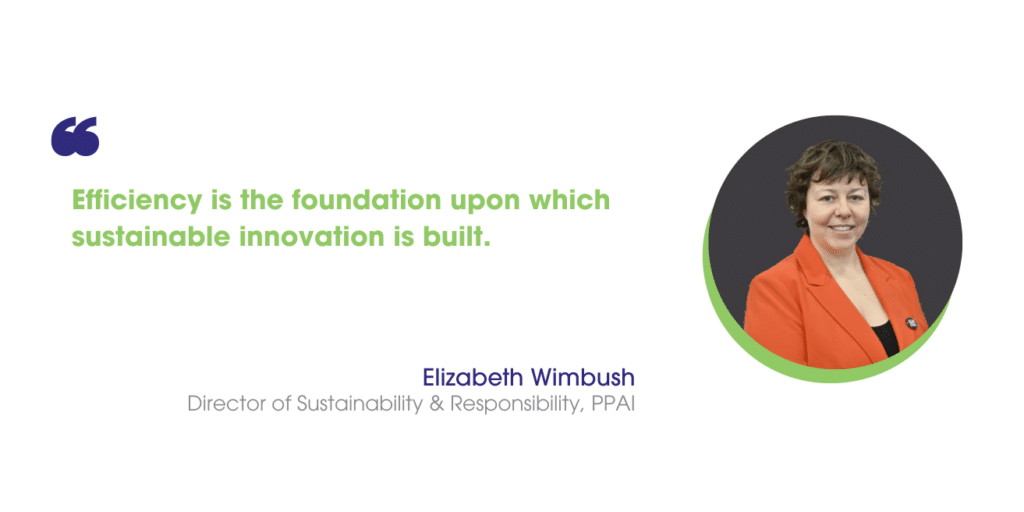As we navigate the evolving landscape of the promotional products industry, one thing is becoming increasingly clear: innovation is key to our future success.
In a world where sustainability is no longer a buzzword but a fundamental expectation, the companies that thrive will be those that embrace sustainable practices as part of their broader innovation strategies. At the heart of this transformation lies the recognition that sustainability and efficiency are often two sides of the same coin, driving cost savings and opening new avenues for growth.
The Intersection Of Innovation And Sustainability
Innovation has always been a key component of our industry – from creating product design to novel marketing strategies, our ability to adapt and evolve has kept us relevant in an ever-changing marketplace. How quickly after the Barbie movie was released were you able to get every imaginable product in that exact shade of pink? Now let that spirit of innovation extend to how we approach sustainability.
It’s not just about reducing our environmental footprint or ensuring fair labor throughout our supply chains; it’s about rethinking the way we do business. It’s about innovating across every aspect of our operations to create more efficient, cost-effective processes that benefit the triple bottom line: profits, people and planet. When we view sustainability through this lens, it becomes clear that sustainable practices aren’t just an added expense, but a strategic investment that can drive long-term profitability.
The First Step Toward Sustainable Innovation
Efficiency is the foundation upon which sustainable innovation is built. By streamlining operations, optimizing resource use and reducing waste, companies can achieve significant cost savings while simultaneously enhancing their positive environmental impact.
Consider the impact of adopting more sustainable packaging. While the initial cost of switching to eco-friendly materials may seem daunting, these materials are often lighter and more compact, leading to lower shipping costs (and carbon intensity!) with reduced storage needs. Over time, these efficiencies add up, transforming a perceived cost into a source of savings and a competitive advantage.

Similarly, innovations in energy efficiency, such as upgrading lighting systems or optimizing heating and cooling operations, can lead to substantial reductions in energy bills. These initiatives may require some upfront investment – consider the potential tax incentives that make them a financially sound choice in the long run. Not only do these efficiency gains reduce costs, but they also enhance a company’s reputation as a responsible and forward-thinking leader in the industry.
Unleashing The Power Of Technology
Technology is a powerful enabler of sustainable innovation. The rise of digital tools and platforms is revolutionizing how we manage resources, design products and engage with customers. Carbon accounting platforms, digital traceability tools using blockchain and supply chain mapping have all become commonplace in the last several years.
By leveraging technology, companies can drive both sustainability and efficiency. Advanced inventory management systems powered by AI can optimize stock levels, reducing overproduction and waste. Similarly, digital printing technologies allow for on-demand production, eliminating the need for large inventory holdings and significantly reducing waste, resulting in fewer products being sent to landfill.
Technology enables companies to better understand and meet the needs of evolving demands of customers. By leveraging customer data analytics, you can pinpoint which sustainability initiatives matter most to your clients. This insight allows you to confidently allocate resources to those initiatives and effectively market your commitment, aligning your efforts with what truly resonates with your audience.
The Market Advantage
Sustainability is increasingly a key differentiator in the marketplace. As customers become more informed and conscientious about the environmental impact of their purchasing decisions, they are looking for brands that share their values. Companies that can integrate sustainability into their core operations effectively communicate that they’re better positioned to meet this demand.
This market advantage is not just theoretical – it’s real and measurable. Companies that prioritize sustainability see increased customer and employee loyalty, higher sales and a stronger brand reputation. Furthermore, as regulatory pressures around environmental responsibility continue to grow, those who have already embedded sustainable practices into their operations will be better equipped to comply with new regulations, avoiding potential fines and penalties.
A Call To Action
We stand at the forefront of an industry that is ripe for innovation. By embracing sustainable practices, we can drive efficiencies, reduce costs and position our companies as leaders in the market. But more than that, we can contribute to a more sustainable future, one where business success goes with environmental and social responsibility.
I encourage you all to view sustainability not as an added burden but as a catalyst for innovation. Whether it’s exploring new materials, adopting cutting-edge technologies or rethinking traditional processes, every step we take toward sustainability is a step toward greater efficiency, profitability and market relevance.
Wimbush is the director of sustainability and responsibility at PPAI.


